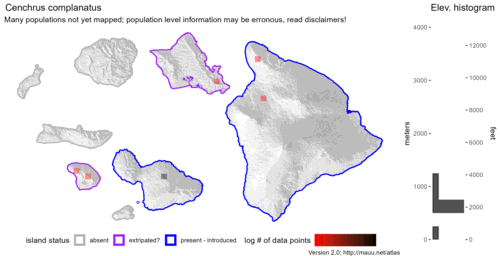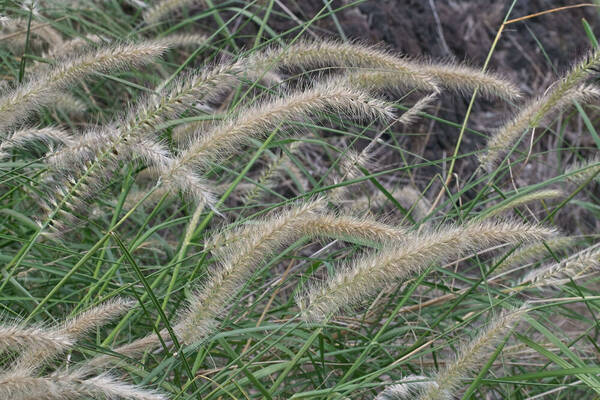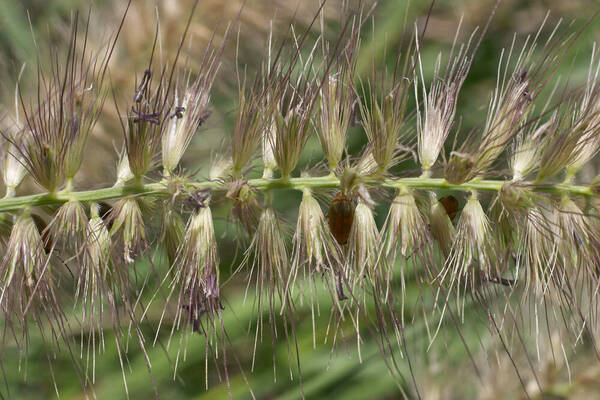Info
Subfamily: Panicoideae
Genus etymology: Cenchrus = "millet" [Greek]. However this is a misnomer, the only millet species in this genus is C. americanus, and this was treated as Pennisetum when Cenchrus was erected.
Species etymology: complanatus = "leveled" [Latin] refring to the flattened culms
Photosynthetic type: C4 (warm season)
Nativity: naturalized - intentional
First recorded in Hawaiʻi: 1928
Map

Inflorescence
 image credit: Sune_Holt
image credit: Sune_HoltSpikelets
 image credit: Sune_Holt
image credit: Sune_HoltDescription
Habit: Perennial. Rhizomes elongated. Culms geniculately ascending, or decumbent; 75-200 cm long; 2-3 mm diam.; without nodal roots, or rooting from lower nodes. Culm-nodes glabrous, or pubescent. Lateral branches ample; arising from lower culm and mid culm. Leaf-sheaths longer than adjacent culm internode; outer margin glabrous, or hairy. Ligule a fringe of hairs; 1-1.6 mm long. Leaf-blades flat, or conduplicate; 15-55 cm long; 3-7 mm wide. Leaf-blade surface scabrous; glabrous; hairless except near base. Inflorescences: Inflorescence a panicle. Panicle spiciform; linear, or oblong; 8-12 cm long; 0.7-1 cm wide. Primary panicle branches accrescent to a central axis; with lateral stumps on axis. Panicle axis angular; scabrous; with scattered hairs; bearing deciduous spikelet clusters. Spikelets subtended by an involucre. Fertile spikelets sessile; 1 in the cluster. Involucre composed of bristles; oblong; 8-12 mm long; base obtuse; base 0.7 mm long. Involucral bristles deciduous with the fertile spikelets; numerous; with an outer whorl of thinner bristles; inner bristles longer than outer; with one conspicuously longer bristle; 10-15 mm long; terete; flexible; glabrous. Spikelets: Spikelets comprising 1 basal sterile florets; 1 fertile florets; without rhachilla extension. Spikelets ovate; dorsally compressed; acute; 5-6 mm long; falling entire; deciduous with accessory branch structures. Fertile Spikelets: Spikelets comprising 1 basal sterile florets; 1 fertile florets; without rhachilla extension. Spikelets ovate; dorsally compressed; acute; 5-6 mm long; falling entire; deciduous with accessory branch structures. Glumes: Glumes shorter than spikelet; thinner than fertile lemma. Lower glume ovate, or orbicular; 0.33 length of spikelet; 0-1 -veined. Lower glume lateral veins absent. Upper glume ovate; 3.8-4.6 mm long; 0.75 length of spikelet; membranous; without keels; 5 -veined. Upper glume apex acute. Florets: Basal sterile florets male; with palea. Lemma of lower sterile floret ovate; 1 length of spikelet; membranous; 7 -veined; acute. Fertile lemma ovate; 4.4-5.7 mm long; chartaceous; without keel; 5 -veined. Lemma margins flat. Lemma apex acute. Palea chartaceous. Flowers: Lodicules absent. Anthers 3; 2.4-3.6 mm long; orange. Styles connate below. Fruits: Caryopsis with adherent pericarp. Distribution: Pacific: north-central. North America: Mexico. South America: Mesoamericana.
(Description source: Clayton, W.D., Vorontsova, M.S., Harman, K.T. and Williamson, H. (2006 onwards). GrassBase - The Online World Grass Flora. Available at https://powo.science.kew.org )